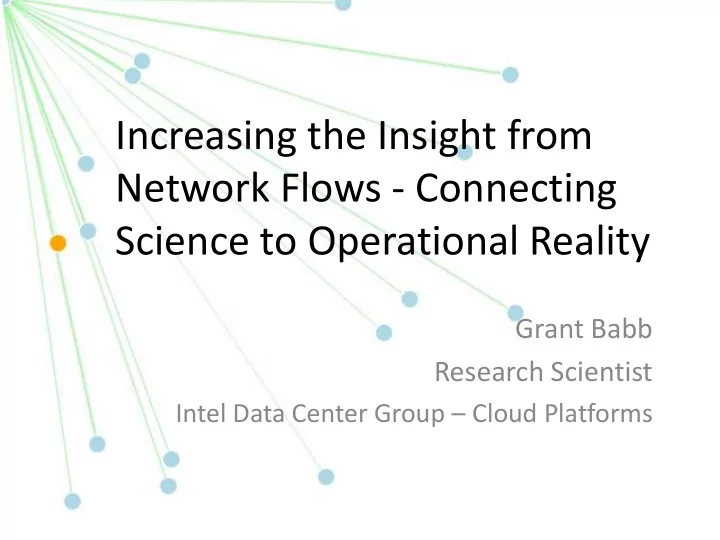

Increasing the Insight from Network Flows - Connecting Science to Operational Reality Grant Babb Research Scientist Intel Data Center Group – Cloud Platforms
Objectives • The BIG question • Why netflows? • Why transform them? • What analytics to use?
The BIG Question What are the patterns in my network flow data that will identify a potential security threat?
Bridging the Gap Security Events – Large amount of time Real-time alerting on what information lost, only know occurrence, further you know already analysis difficult if not impossible Ease of Analysis Data Size X Network Flows – sampling makes analysis Telemetry data to find new feasible, some information lost but not much, insight, or deeper analysis still a high noise-low signal problem from events 2X Packet Stream – no sampling of data, would Forensic data for an identified require a complete copy of network data for threat you want to observe analysis 100X
Netflows as Time Series t = 60*hr + min Byteval * flow IP 172.20.0.3 – 10.3.1.25 Channels 10.31.1.64 – 132.21.8.9 Time steps (0-1440)
Transforming Netflows • Training – load sample of IP channels as composite 12-bit/52-bit keys • Optimization - create the set of empirical quantiles using index keys in the training data • Transform – use quantiles and binary search to split processing across workers, add or update values in matrix
Algorithm Results
Order of Complexity … Scalable! Binary search O(log n) + Direct search O(c log n) = Algorithm O(n [1+c] log n) Compare to O(n 2 )
Analytic Approach Network Signal Pattern Analysis Analysis Analysis Visual Analysis
Graph Analysis: Latent Dirichlet Allocation • Tries to put a population into sub-groups based on SRCIP 1 DSTIP 1 their similarity • Used with documents and SRCIP 2 DSTIP 2 the words in them to DSTIP 3 SRCIP 3 suggest “topics” DSTIP 4 • IP addresses are nodes, SPORT 1 flow details are edges DPORT 1 SPORT 2 • Use to cluster on known DPORT 2 SPORT 3 (profiling) or unknown (automated behavior) connections Bytes/packets Bytes/packets
LDA results • Question: What are the strongest matches for groups based on automated communication to well- known ports ? • Answer: Seven ports in four different groups are the strongest matches
Patterns : Principal Component Analysis T N N T * (Λ N * I) * Coefficients Dynamic = Time Series Data Patterns N N T The Use of PCs to summarize … climatological fields has been found to be so valuable that is almost routine – Joliffe, Principal Component Analysis
PCA Results • Question: Are there any anomalous patterns in this data? • Answer: One source IP is talking to several destination IP’s that do not exist (horizontal scan)
Signal Analysis: Fast Fourier Transform • Represent flow data as a function of sines and cosines (waves) • Jump from time domain to frequency domain (and back) • Easily filter noise from signal, or remove other frequencies
Signal Analysis - FFT
Visual Analytics: IPython and D3
References • Babb, Grant; Ross, Alan: Increasing the Insight from Network Flows - Connecting Science to Operational Reality , Draft Publication • Kutz, J. Nathan: Data-Driven Modeling & Scientific Computation • Joliffe, I. T.: Principal Component Analysis • Blei, David M.: Introduction to Probabilistic Topic Models • Chakravarty, Sambuddho et al: On the Effectiveness of Traffic Analysis Against Anonymity Networks Using Flow Records • Cloudera Hadoop: http://cloudera.com • Intel Analytics Toolkit: http://www.intel.com/content/www/us/en/software/intel-graph- solutions.html • IPython, NumPy, Matplotlib: http://ipython.org • SciPy: http://scipy.org • D3: http://d3js.org
Questions?
Thanks
Recommend
More recommend